Superelastic Properties of Aged FeNiCoAlTaB Cold-Rolled Shape Memory Alloys
Abstract
:1. Introduction
2. Materials and Methods
3. Results and Discussion
3.1. Hardness in NCATB
3.2. Crystal Structure in NCATB
3.3. Size of Precipitates in NCATB
3.4. Development of Texture in NCATB
3.5. Grain Morphology in NCATB
3.6. Superelastic Properties of NCATB
4. Conclusions
- Under an annealing condition of 0.5 h, for cold-rolled NCATB SMAs, the average size of grain was 210 μm. When the annealing time increased to 1 h, the average grain size increased to 1570 μm. Moreover, the fraction of low-angle boundaries increased from 15.4% to 39.5% when the annealing time was extended from 0.5 h to 1 h. Normal grain growth was exhibited when the annealing time was 0.5 h. When the annealing time was increased from 0.5 h to 1 h, the mechanism of grain growth changed to abnormal growth.
- TEM results indicated that the sizes of the precipitates were between 10 nm for the PXL700 °C-6 h sample and around 18 nm for the PXL700 °C-12 h sample. The precipitates had an L12 crystal structure, and the austenite had an FCC structure. The precipitates were also found to be enriched with Ni, Ta, and Al.
- A superelastic strain of 3% and a maximum tensile elongation of 6% were recorded for the NCATB polycrystalline alloy with a high proportion of low-angle grain boundaries and large grain sizes in a tensile test at room temperature. PXL700 °C-6 h exhibited higher critical stress values than PXL700 °C-12 h due to its lower transformation temperatures. The DIC results revealed that two martensite variants could activate during the superelastic test, with the recoverable strain decreasing due to retained martensite. Dislocations pinned the martensite phase to prevent it from reversing back to austenite. As a result, the large volume fraction of martensite was retained in the tensile sample, and this contributed to irrecoverable strain.
Author Contributions
Funding
Data Availability Statement
Acknowledgments
Conflicts of Interest
References
- Otsuka, K.; Wayman, C.M. Shape Memory Materials; Cambridge University Press: Cambridge, UK, 1998; pp. 117–132. [Google Scholar]
- Costanza, G.; Tata, M.E. Shape memory alloys for aerospace, recent developments, and new applications: A short review. Materials 2020, 13, 1856. [Google Scholar] [CrossRef]
- Jani, J.M.; Leary, M.; Subic, A.; Gibson, M.A. A review of shape memory alloy research, applications and opportunities. Mater. Des. 2014, 56, 1078–1113. [Google Scholar] [CrossRef]
- Tanaka, Y.; Himuro, Y.; Kainuma, R.; Sutou, Y.; Omori, T.; Ishida, K. Ferrous polycrystalline shape-memory alloy showing huge superelasticity. Science 2010, 27, 1488–1490. [Google Scholar] [CrossRef]
- Omori, T.; Abe, S.; Tanaka, Y.; Lee, D.; Ishida, K.; Kainuma, R. Thermoelastic martensitic transformation and superelasticity in Fe–Ni–Co–Al–Nb–B polycrystalline alloy. Scr. Mater. 2013, 69, 812–815. [Google Scholar] [CrossRef]
- Lee, D.; Omori, T.; Kainuma, K. Ductility enhancement and superelasticity in Fe–Ni–Co–Al–Ti–B polycrystalline alloy. J. Alloys Compd. 2014, 617, 120–123. [Google Scholar] [CrossRef]
- Tseng, L.W.; Ma, J.; Karaman, I.; Wang, S.J.; Chumlyakov, Y. Superelastic response of the FeNiCoAlTi single crystals under tension and compression. Scr. Mater. 2015, 101, 1–4. [Google Scholar] [CrossRef]
- Ma, J.; Hornbuckle, B.; Karaman, I.; Thompson, G.B.; Luo, Z.; Chumlyakov, Y. The effect of nanoprecipitates on the superelastic properties of FeNiCoAlTa shape memory alloy single crystals. Acta Mater. 2013, 61, 3445–3455. [Google Scholar] [CrossRef]
- Geng, Y.; Lee, D.; Xu, X.; Nagasako, M.; Jin, X.; Omori, T.; Kainuma, R. Coherency of ordered γ’ precipitates and thermoelastic martensitic transformation in FeNiCoAlTaB alloys. J. Alloys Compd. 2015, 628, 287–292. [Google Scholar] [CrossRef]
- Abuzaida, W.; Sehitoglu, H. Shape memory effect in FeMnNiAl iron-based shape memory alloy. Scr. Mater. 2019, 169, 57–60. [Google Scholar] [CrossRef]
- Chumlyakov, Y.I.; Kireeva, I.V.; Pobedennaya, P.; Krooβ, P.; Niendorf, T. Rubber-like behaviour and superelasticity of [001]-oriented FeNiCoAlNb single crystals containing γ- and β-phase particles. J. Alloys Compd. 2021, 856, 158158. [Google Scholar] [CrossRef]
- Chumlyakov, Y.I.; Kireeva, I.V.; Pobedennaya, Z.V.; Krooβ, P.; Niendorf, T. Shape memory effect and superelasticity of [001]-oriented FeNiCoAlNb single crystals aged under and without stress. Metals 2021, 11, 943. [Google Scholar] [CrossRef]
- Zhang, C.; Zhu, C.; Shin, S.; Casalena, L.; Vecchio, K. Multifunctional non-equiatomic high entropy alloys with superelastic, high damping, and excellent cryogenic properties. Adv. Eng. Mater. 2019, 21, 1–9. [Google Scholar] [CrossRef]
- Zhang, C.; Zhu, C.; Shin, S.; Casalena, L.; Vecchio, K. Grain boundary precipitation of tantalum and NiAl in superelastic FeNiCoAlTaB alloy. Mater. Sci. Eng. A 2019, 743, 372–381. [Google Scholar] [CrossRef]
- Zhao, H.; Fu, H.; Xie, J.; Zhang, Z. Effects of solution treatment on microstructure and superelasticity of FeNiCoAlTaB alloy. Mater. Res. Express 2018, 5, 016508. [Google Scholar] [CrossRef]
- Fu, H.; Li, W.; Song, S.; Jiang, Y.; Xie, J. Effects of grain orientation and precipitates on the superelasticity in directionally solidified FeNiCoAlTaB shape memory alloy. J. Alloys Compd. 2016, 684, 556–563. [Google Scholar] [CrossRef]
- Choi, W.S.; Pang, E.L.; Choi, P.P.; Schuh, C.A. FeNiCoAlTaB superelastic and shape-memory wires with oligocrystalline grain structure. Scr. Mater. 2020, 188, 1–5. [Google Scholar] [CrossRef]
- Zhang, C.; Yu, Q.; Tang, Y.T.; Xu, M.; Wang, H.; Zhu, C.; Ell, J.; Zhao, S.; MacDonald, B.E.; Cao, P.; et al. Strong and ductile FeNiCoAl-based high-entropy alloys for cryogenic to elevated temperature multifunctional applications. Acta Mater. 2023, 242, 118449. [Google Scholar] [CrossRef]
- Czerny, M.; Cios, G.; Maziarz, W.; Chumlyakov, Y.I.; Schell, N.; Chulist, R. Effect of B addition on the superelasticity in FeNiCoAlTa single crystals. Mater. Des. 2021, 197, 109225. [Google Scholar] [CrossRef]
- Wójcik, A.; Chulist, R.; Szewczyk, A.; Dutkiewicz, J.; Maziarz, W. The influence of γ ′ precipitates on the structural stability of FeNiCoAlTa and FeNiCoAlTaB single crystals after cyclic superelastic deformation. Arch. Metall. Mater. 2023, 68, 1157–1164. [Google Scholar] [CrossRef]
- Zhou, Z.; Cui, J.; Ren, X. Phase diagram of FeNiCoAlTaB ferrous shape memory alloy on aging time. AIP Adv. 2017, 7, 045019. [Google Scholar] [CrossRef]
- Tseng, L.W.; Ma, J.; Hornbuckle, B.; Karaman, I.; Thompson, G.B.; Luo, Z.; Chumlyakov, Y. The effect of precipitates on the superelastic response of [100] oriented FeMnAlNi single crystals under compression. Acta Mater. 2015, 97, 234–244. [Google Scholar] [CrossRef]
- Toth, L.S.; Biswas, S.; Gu, C.; Beausir, B. Notes on representing grain size distributions obtained by electron backscatter diffraction. Mater. Charact. 2013, 84, 67–71. [Google Scholar] [CrossRef]
- Burke, J.E.; Turnbull, D. Recrystallization and grain growth. Prog. Met. Phys. 1952, 3, 220–292. [Google Scholar] [CrossRef]
- Raabe, D. Recovery and recrystallization: Phenomena, physics, models, simulation. Phys. Metall. 2014, 2291–2397. [Google Scholar] [CrossRef]
- Hillert, M. On the theory of normal and abnormal grain growth. Acta Metall. 1965, 13, 227–238. [Google Scholar] [CrossRef]
- Tseng, L.W.; Lee, P.Y.; Lu, N.H.; Hsu, Y.T.; Chen, C.H. Shape memory properties and microstructure of FeNiCoAlTaB shape memory alloys. Crystals 2023, 13, 852. [Google Scholar] [CrossRef]
- Ball, J.M.; James, R.D. Fine phase mixtures as minimizers of energy. Arch Ration Mech Anal. 1987, 100, 13. [Google Scholar] [CrossRef]
- Khalil-Allafi, J.; Dlouhy, A.; Eggeler, G. Ni4Ti3-precipitation during aging of NiTi shape memory alloys and its influence on martensitic phase transformations. Acta Mater. 2002, 50, 4255–4274. [Google Scholar] [CrossRef]

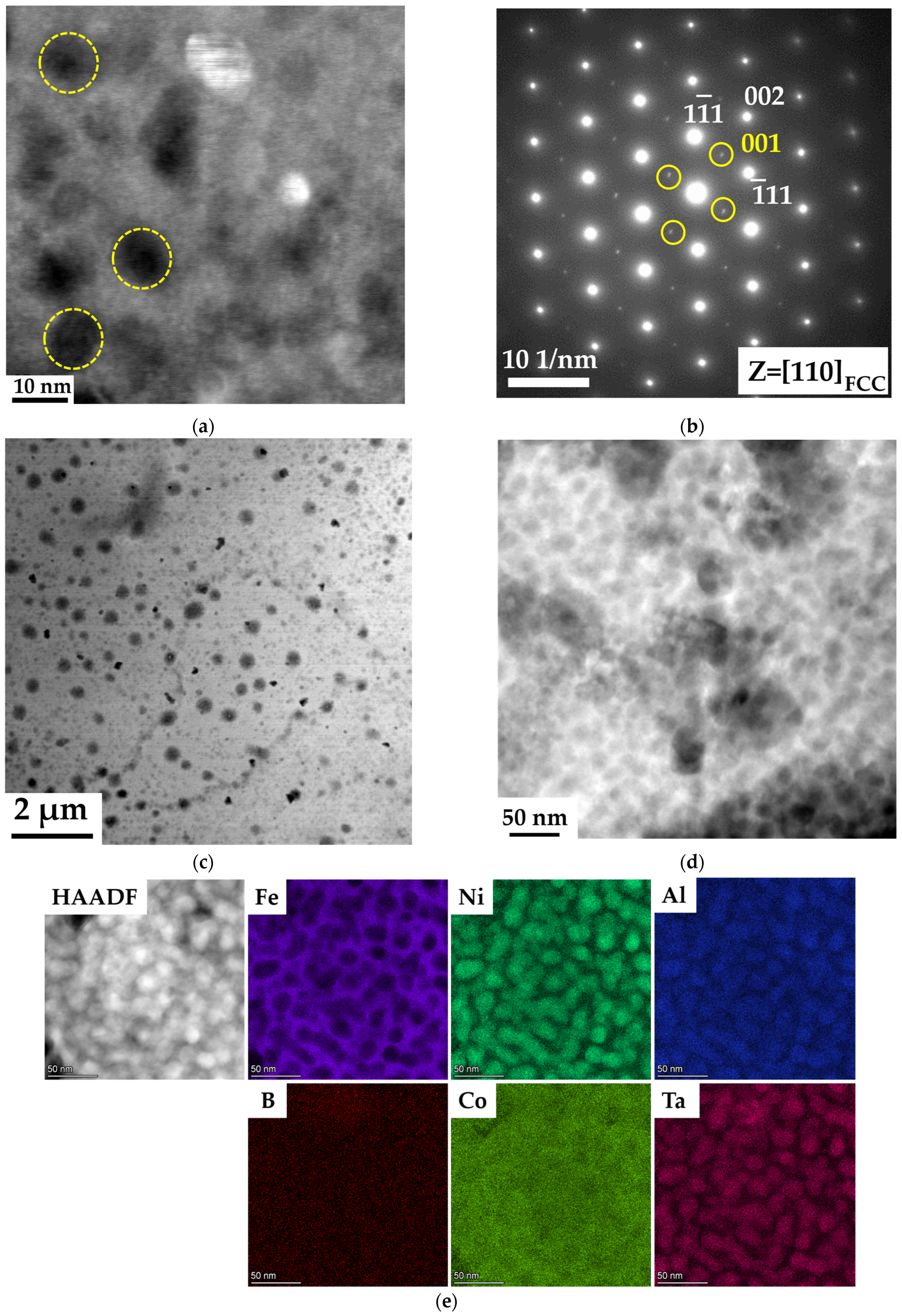
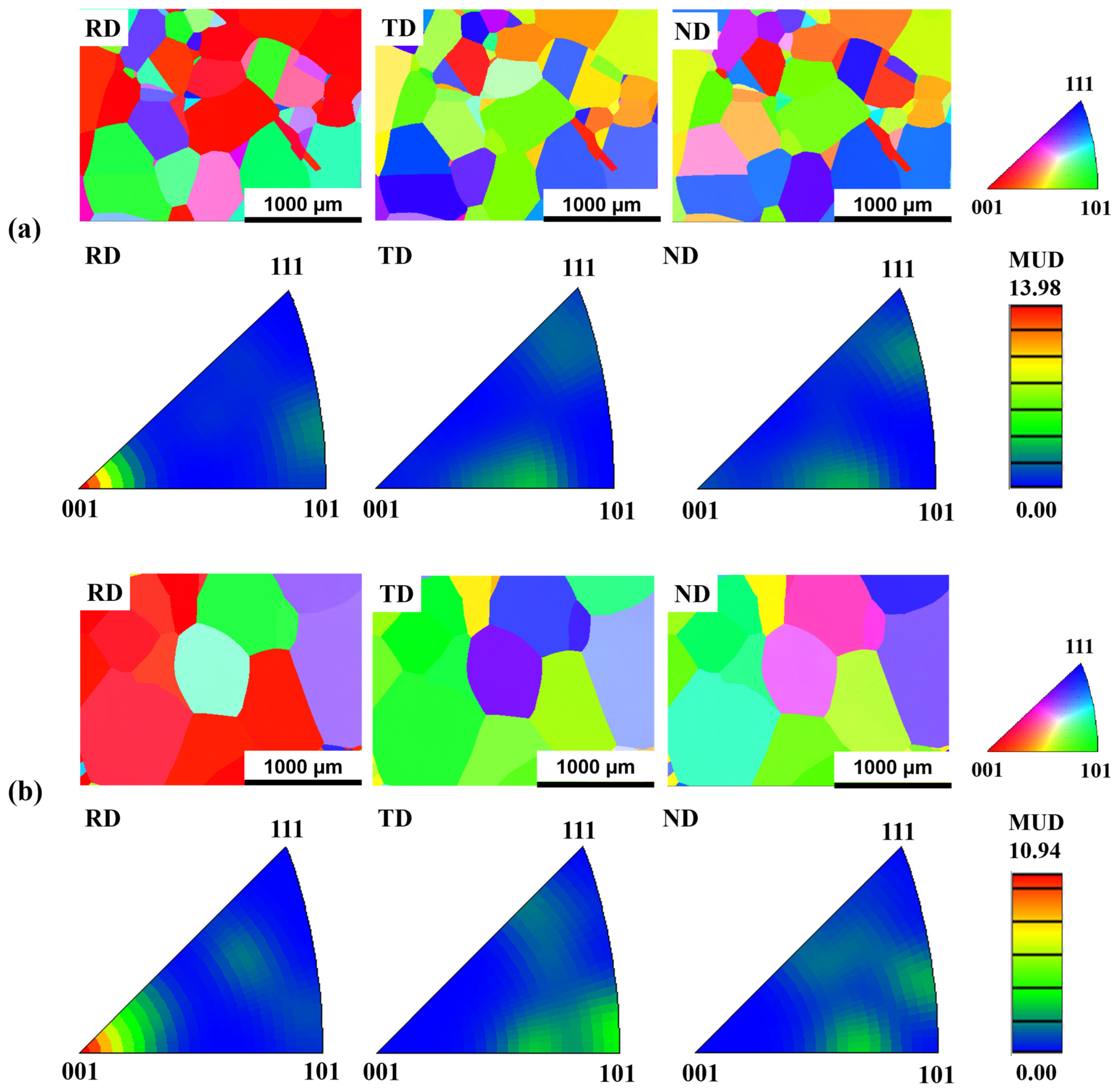



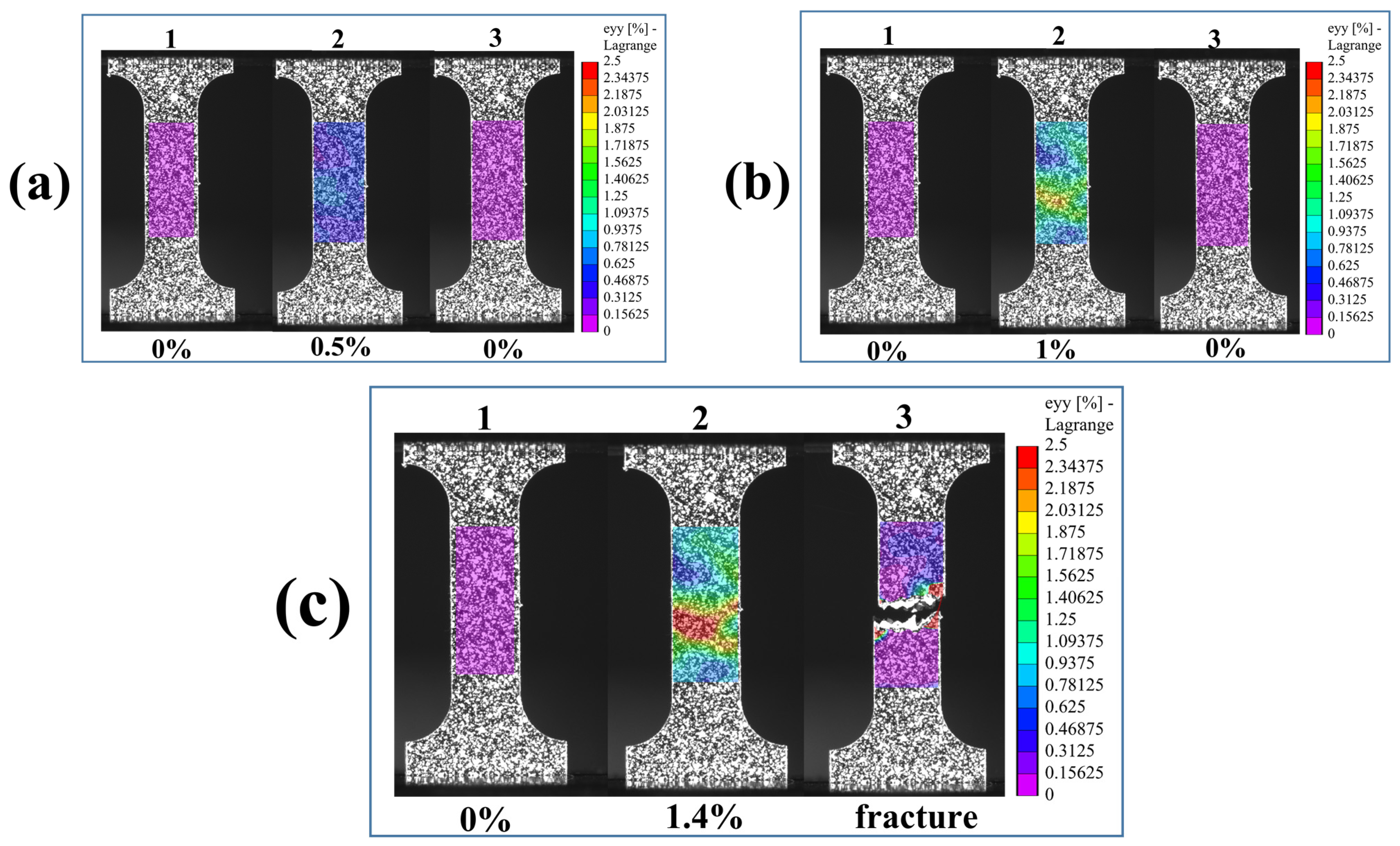
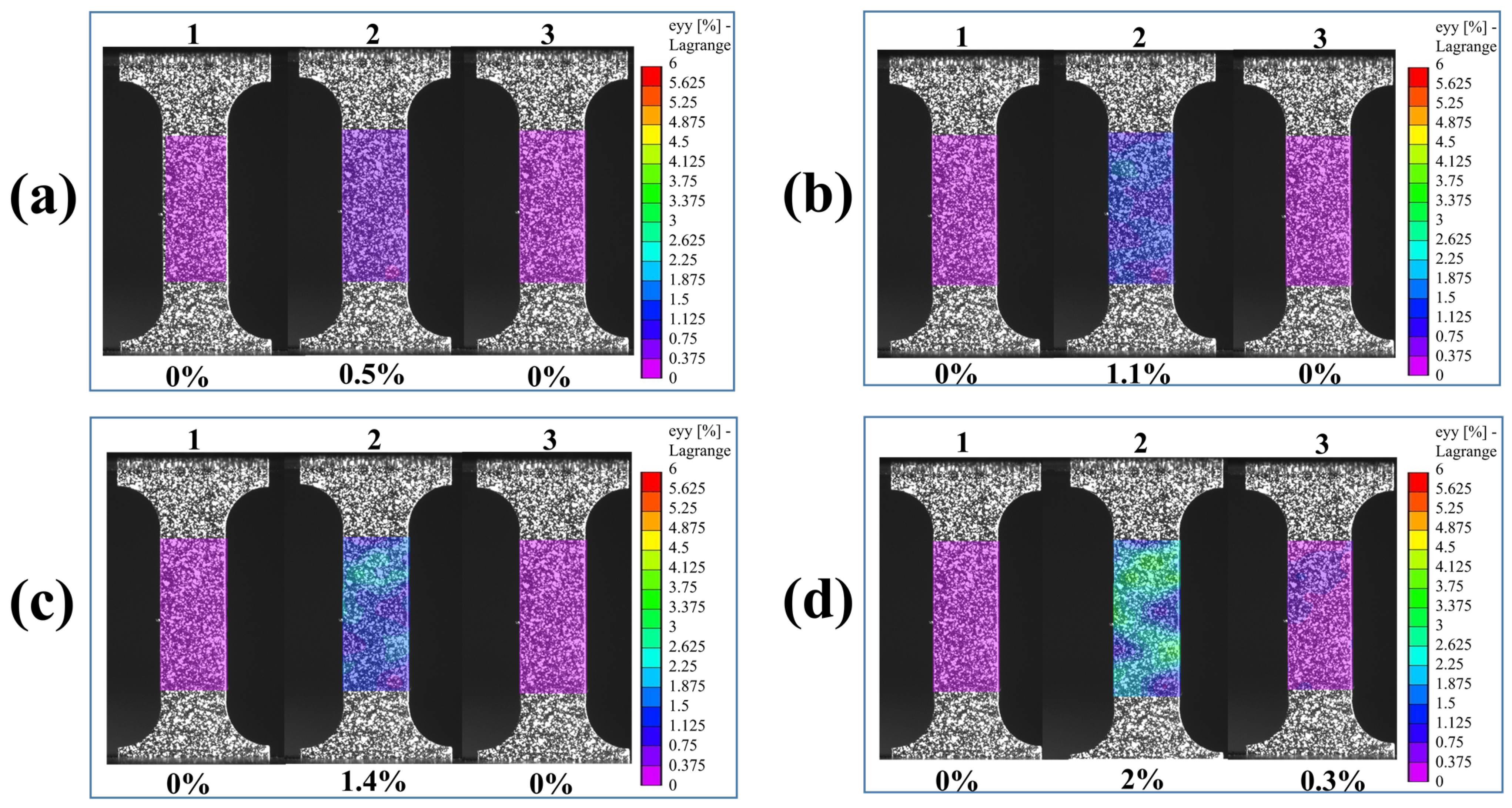
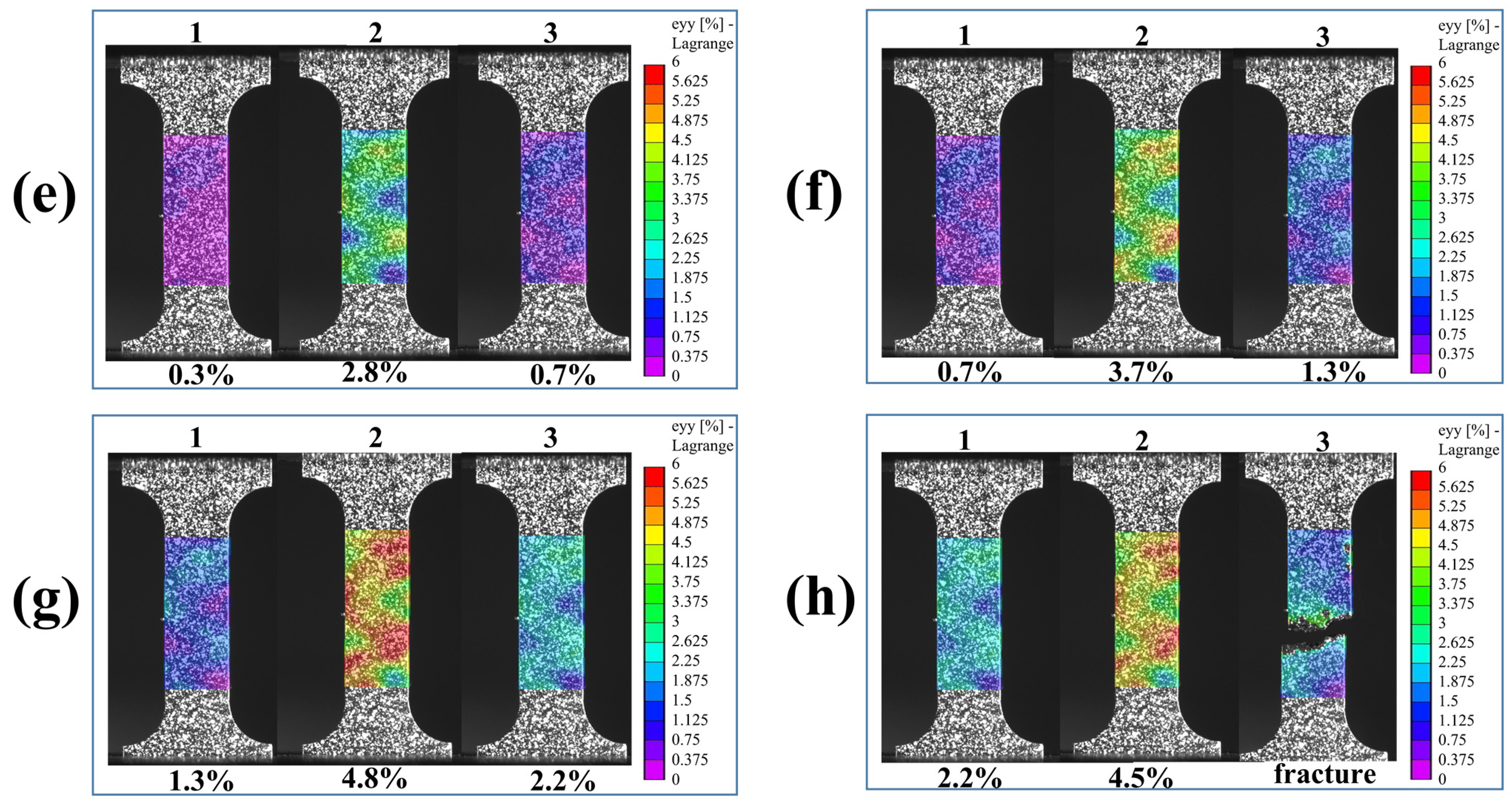
| NCATB | Fe40.95Ni28Co17Al11.5Ta2.5B0.05 | RD | rolling direction |
| CR97 | cold rolled 97% | ND | normal direction |
| PXL700 °C-6 h | CR97 + 1250 °C-1 h + 700 °C-6 h | TD | transverse direction |
| PXL700 °C-12 h | CR97 + 1250 °C-1 h + 700 °C-12 h | CVPs | corresponding variant pairs |
| εrec | recoverable strain | εirrec | irrecoverable strain |
| σc | critical stress | d | grain size |
| d/t | relative grain size | t | sample thickness |
| γ | austenite phases | γ′ | L12 precipitates |
| Thermomechanical Processing | Vickers Hardness (HV) |
|---|---|
| CR97 | 423 ± 6 |
| CR97 + 1250 °C-1 h | 225 ± 4 |
| CR97 + 1250 °C-1 h + 700 °C-6 h | 460 ± 7 |
| CR97 + 1250 °C-1 h + 700 °C-12 h | 486 ± 8 |
| Superelastic Properties | PXL700 °C-6 h | PXL700 °C-12 h |
|---|---|---|
| Critical stress (MPa) | 765 | 560 |
| Fracture stress (MPa) | 795 | 670 |
| Maximum recoverable strain (%) | 1 | 2.6 |
| Ductility (%) | 1.3 | 5 |
Disclaimer/Publisher’s Note: The statements, opinions and data contained in all publications are solely those of the individual author(s) and contributor(s) and not of MDPI and/or the editor(s). MDPI and/or the editor(s) disclaim responsibility for any injury to people or property resulting from any ideas, methods, instructions or products referred to in the content. |
© 2024 by the authors. Licensee MDPI, Basel, Switzerland. This article is an open access article distributed under the terms and conditions of the Creative Commons Attribution (CC BY) license (https://creativecommons.org/licenses/by/4.0/).
Share and Cite
Tseng, L.-W.; Song, M.; Chen, W.-C.; Hsu, Y.-T.; Chen, C.-H. Superelastic Properties of Aged FeNiCoAlTaB Cold-Rolled Shape Memory Alloys. Metals 2024, 14, 643. https://doi.org/10.3390/met14060643
Tseng L-W, Song M, Chen W-C, Hsu Y-T, Chen C-H. Superelastic Properties of Aged FeNiCoAlTaB Cold-Rolled Shape Memory Alloys. Metals. 2024; 14(6):643. https://doi.org/10.3390/met14060643
Chicago/Turabian StyleTseng, Li-Wei, Miao Song, Wei-Cheng Chen, Yi-Ting Hsu, and Chih-Hsuan Chen. 2024. "Superelastic Properties of Aged FeNiCoAlTaB Cold-Rolled Shape Memory Alloys" Metals 14, no. 6: 643. https://doi.org/10.3390/met14060643






